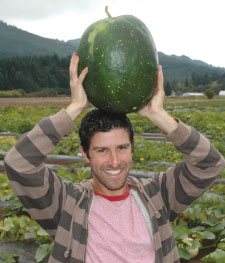Supporting biodiversity with heirlooms
by Bill Thorness
This article was originally published in April 2010

(April 2010) — Josh Kirschenbaum stopped in the middle of the field, bent over a tangle of leaves, pulled a bit at the vines, and uncovered a deep-green globe freckled with yellow dots. That Moon and Stars watermelon, an heirloom variety, was one of 1,200 vegetable and fruit varieties growing on the Territorial Seed Company trial farm.
“Heirloom vegetable sales are growing,” said Kirschenbaum, manager of the 44-acre farm, at the edge of the Willamette Valley south of Eugene. He grows out samples of Territorial seeds, studying each variety for purity, vigor and other desirable qualities.
Moon and Stars, for instance, has yellow-flecked leaves and a speckled, thick rind, with a mild, juicy, red flesh that’s “kinda seedy,” he said. It may not be the ideal supermarket watermelon, where seedless and sweet are prized but, he added, “last year it was one of the earliest maturing for its size.” For gardeners, that makes it a keeper.
An heirloom vegetable or fruit often is defined as a variety that’s at least 50 years old, is open-pollinated, and arrived through natural breeding methods. It generally isn’t grown commercially, although today at PCC you’ll find heirloom tomatoes, potatoes, eggplant and more.
In the past, heirloom seed was passed down from generation to generation and carried by immigrants to their new homes, both as a reminder of their homeland and for practical reasons: they knew how to grow it, and that it would feed them.
Those traveling seeds, like their owners, came with some great stories.
For instance, the Ozette potato, a knobby fingerling with mild yellow flesh, is possibly the only potato that didn’t travel to Europe before coming to America. It was carried by shipgoing Spanish explorers up the coast from Peru to Washington in the 1700s, where it was given to the Makah people at Ozette, and has been growing there ever since.
Seeds for the Walla Walla Sweet onion were brought to Washington from the island of Corsica by a French soldier in the 1880s, where the variety was embraced by Walla Walla’s Italian immigrants.
The Cherokee Trail of Tears bean was carried by the Cherokee people when the U.S. Army forcibly relocated them to Oklahoma from the Southeast in the winter of 1838. On the “Trail of Tears” through the Great Smoky Mountains, some 4,000 people died. The bean survived and is still grown today, a slender green bean with a purple stripe that can be eaten fresh, or left to dry for its glossy black seeds.
Heirlooms may remind us of the past, but they also are a symbol of biodiversity. While we may typically eat the same variety of carrot or grow our favorite tomato, we must acknowledge that having 100 varieties of tomatoes, and dozens of carrot choices, is good for the gene pool. Loss of diversity generally is a one-way road, irreversible and catastrophic.
Aiding preservation
Preserving heirloom varieties is the opposite of genetic engineering: it supports and celebrates an ancient seed-saving practice, and values existing varieties for the strengths they bring to the collective gene pool. It may be one of the few effective actions against the monoculture, seed-patenting trend.
Heirloom preservation has received heightened attention recently, and not just because of opposition to GE “Frankenfoods.” In our increasingly technological lifestyles, there’s a renewed appreciation of connections to our past.
Growing the old varieties is becoming a regular gardening activity, and the craze for fresh, local food has people seeking heirloom flavors and uniqueness in grocery stores, at farmers’ markets and on restaurant menus.
“I had to go 5,000 miles away to eat food that tasted like home,” recalled Lynne Rossetto Kasper, Splendid Table radio host, at the 2008 Seed Savers Exchange convention. Her first cookbook was inspired by her Italian food heritage.
Traditional foods, whether brought by immigrants or grown by native peoples, are gaining recognition. The Ozette potato is part of the Slow Food Ark of Taste, which identifies foods with a significant history that are in danger of being lost.
So is the Moon and Stars melon. Once thought to be extinct, it was brought back in the 1980s due to extensive searching by Kent Whealy, co-founder of Seed Savers Exchange, where it’s now a top-selling variety.
Bill Thorness is the author of “Edible Heirlooms: Heritage Vegetables for the Maritime Garden” and is Seattle Tilth’s editor. He will be speaking April 22 at Eagle Harbor Books on Bainbridge Island, and April 24 at City People’s Garden Store in Seattle. More information at edibleheirlooms.com.
